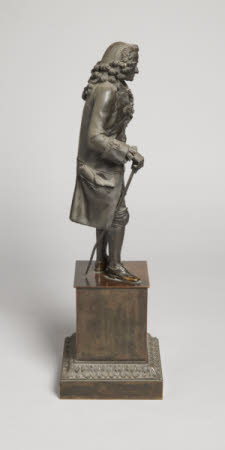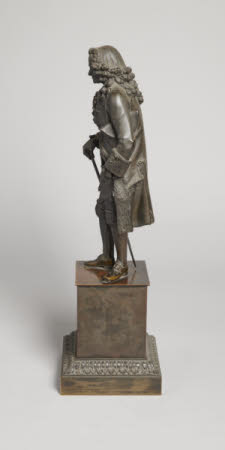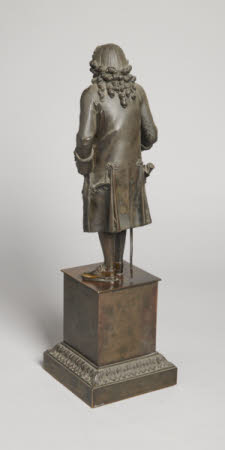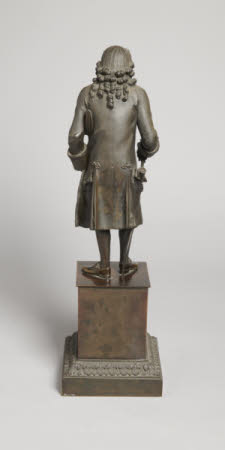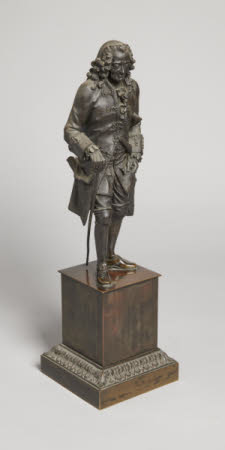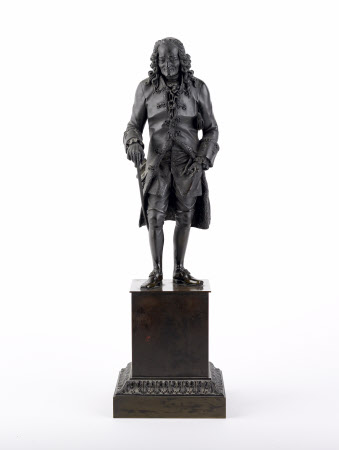Statuette of Voltaire (François-Marie Arouet, 1694-1778)
after François-Marie Suzanne (c. 1750- after 1802)
Category
Art / Sculpture
Date
c. 1820 - 1860
Materials
Bronze
Measurements
527 x 152 mm; 152 mm (L)
Place of origin
France
Order this imageCollection
The Argory, County Armagh
NT 565222
Summary
Sculpture, bronze; statuette of Voltaire (François-Marie Arouet, 1694-1778) ; French, after François-Marie Suzanne (c. 1750- after 1802); c. 1820-1860. A standing figure of the celebrated writer and philosopher Voltaire, a leading figure within the eighteenth-century European enlightenment. The model was made by the little-known sculptor Suzanne, who in 1792 presented to the French revolutionary parliament plaster figures of Voltaire and his fellow philosopher Jean-Jacques Rousseau. The standing figures of the two philosophers are almost certainly based on those models.
Full description
A bronze statuette of the writer, historian and philosopher François-Marie Arouet, known as Voltaire (1694-1778), after a model attributed to François-Marie Suzanne (c. 1750- after 1802). Voltaire is shown in old age, bewigged and dressed for winter, in breeches and a long frockcoat, unbuttoned towards the bottom to reveal the coat’s fur lining. He stands, left hand in his coat pocket and right hand holding a cane, whilst a rolled manuscript protrudes from his right pocket, and a tricorne hat is held under the left arm. Mounted on a bronze base with a palmette frieze towards the bottom. Voltaire was one of the most important figures in the European Enlightenment. Born François-Marie Arouet, in 1718 he invented for himself the new name de Voltaire, by which he would become universally known. A brilliant pupil, Voltaire achieved early fame with his poem 'La Henriade', celebrating the French king Henri IV and published in 1723. Between 1726 and 1728 he spent a highly formative period in Britain and between 1750 and 1753 he was a guest of the Prussian monarch Frederick II at his court in Potsdam. Even during his lifetime, there was a huge demand for portraits of Voltaire, which the subject did his best to discourage, refusing to allow himself to be painted or sculpted. It was only after he had later in life moved to his secluded home of Ferney, close to Geneva, that Voltaire invited a minor local sculptor, Joseph Rosset (1706-1786) to make his portrait. Although the first miniature ivory bust that Rosset and his son made did not find favour with Voltaire, subsequent portraits were much more successful, to the extent that Rosset and his sons were able to develop a highly successful business in statuettes, portrait busts and portrait reliefs of Voltaire and other celebrated figures in French culture and history (Fischer 1919; Pierre-Dulau 2013). The bronze statuette of Voltaire has a pair, a similar standing figure of Voltaire’s contemporary and fellow philosophe Jean-Jacques Rousseau (1712-1778). A pair of the figures is at Wallington (NT 583164 and 583165), given to Thomas Babington, Lord Macaulay, in around 1840. The two figures are known in many versions and also in other materials, marble, plaster and even papier-mache. They often appear in sale rooms as attributed to Joseph Rosset, but they are not his work (Pierre-Dulau 2013, pp. 363-64, no. 82). Instead the models were in fact made by the little-known French sculptor François-Marie Suzanne (Lami 1910-11, II, pp. 350-51). In July 1792, Suzanne presented to the revolutionary parliament, the Assemblée Nationale, plaster figures of Rousseau, Voltaire and the comte de Mirabeau (1749-91), a leading figure in the early stages of the French revolution. The bronze statuettes of Voltaire and Rousseau are very likely to be derivations from these figures. Jeremy Warren September 2022
Provenance
By descent; Walter McGeough Bond (1908-86), by whom given to the National Trust in 1979.
Makers and roles
after François-Marie Suzanne (c. 1750- after 1802), sculptor
References
Lami 1910-11 : Stanislas Lami, Dictionnaire des sculpteurs de l'école française au dixhuitième siècle, 2 vols., Paris 1910-11 Fischer 1919: U. Fischer, Les Rosset. Une famille de sculpteurs et de peintres comtois, Paris 1919 Montagu 1962 : Jennifer Montagu, ‘Inventaire des tableaux, sculptures, estampes, etc. de l’Institut et musée Voltaire’, Studies on Voltaire and the Eighteenth Century, 20 (1962), pp. 223-47, p. 228. Gagnebin 1976 : Bernard Gagnebin, Album Rousseau. Iconographie, Paris 1976, pp.232-33, fig. 381. Pierre-Dulau 2013 : Marie-Liesse Pierre Dulau, Un atelier jurassien au temps des lumières : les Rosset, PhD dissertation, Université de Strasbourg, 2013, pp. 363-64, no. 82.
